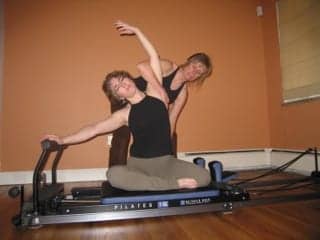Pilates can be an effective rehabilitation intervention for low back pain, but better evidence is needed to grow the practice.
by Lindy D. Royer, PT, PMA-CPT

OVERCOMING THE MODERN LIFESTYLE
The origins of Pilates reach back to Germany, where Joseph H. Pilates was born in the late 1800s. He believed that the “modern” lifestyle, including poor posture and inefficient breathing, were contributing factors to poor health, and dedicated his life to creating and teaching his system of movement to help others—and himself—remain active and vibrant.
In 1926 Joseph Pilates arrived in New York City, where he established a practice in the same building as the New York City Ballet. He and his wife Clara attracted a number of followers in the performing arts community, including Martha Graham and George Balanchine, who often sent their ballet students to Joseph Pilates’ studio.
Some of the students who came to work out at Joseph Pilates’ studio were not only there for fitness. Many had in fact begun to use his method to help recover from injuries. Joseph Pilates developed specific programs for each student based on his or her needs, using a variety of apparatus he invented.
The rules regarding scope of practice we recognize today were not in place when Joseph Pilates was developing his method. Today, Pilates is widely thought of as a fitness method. When applied under the guidance of a professional licensed to provide physical rehabilitation, however, it becomes much more.
PILATES IN THE REHAB SETTING
In 1984 James Garrick and Patrice Whiteside1 introduced dance medicine as a specialty to the Center For Sports Medicine at St. Francis Hospital in San Francisco. Here, Pilates was integrated into the center—the first time a Pilates-based rehabilitation program was included in a clinical setting on the West Coast.
Subsequently, and thanks to pioneers such as Elizabeth Larkam2 and others, Pilates was adopted throughout the United States and in other countries as a rehabilitation tool. By the 1990s, Pilates was experiencing an increase in popularity with practitioners and fitness enthusiasts, and by 2000, Pilates was growing strongly.
Pilates became a popular addition to health clubs and fitness centers, and was incorporated by physical therapists and rehab specialists as part of their treatment protocols. Some innovators pioneered an entirely new model for integrative, whole body rehabilitation by establishing Pilates-based physical therapy centers.
The Pilates Reformer is a mainstay technology used with Pilates practice in the therapeutic setting. This adjustable device uses springs and pulleys to create varying resistance levels for a wide variety of exercises. The Reformer can also be used with attachments that allow Pilates exercises to be modified, thereby helping accommodate clients who have limited range of movement.
In 2010, CNBC reported that Pilates was the fastest-growing activity, with 8.6 million participants, and up more than 450% since 2000.3 The most recent market research from IBIS4 combines the Pilates and yoga industries and indicates a powerful growth pattern for the future.
PILATES AND LOW BACK PAIN
The potential of Pilates as a rehabilitation tool, and its increasing popularity, presents physical therapists with exciting growth opportunities, and it seems the marriage of physical therapy and Pilates is good business and good practice, especially when applied to chronic pain populations, and LBP in particular.
The social and economic impact of low back pain is well documented. A comprehensive 2009 study from the Cecil G. Sheps Center concluded that chronic, impairing low back pain was on the rise, and estimated the costs of LBP at “greater than $100 billion annually, with two-thirds of that due to decreased wages and productivity.”5
Pilates claims to help LBP and, when delivered in small groups, can easily be leveraged as an exercise treatment method, lowering utilization costs and improving outcomes. A well-designed Pilates program trains trunk stability, core activation and control, mobility, strength, and coordination and can be adapted for most populations.
Including Pilates in a clinical practice therefore seems a reasonable addition except for one thing: research. The task of the Pilates rehabilitation community is to present well-designed, credible studies that verify the claim that it improves LBP and other pathologies.
WHAT ABOUT THE EVIDENCE?
The APTA’s 2020 Vision Statement states that physical therapists and physical therapy assistants (PTAs) “will render evidence-based services through the continuum of care.”6 There is anecdotal evidence to support Pilates as an effective tool for rehabilitation, but this is not sufficient justification for clinical practice. If we wish to justify Pilates as a legitimate rehabilitation strategy, no matter what the pathology, we need evidence.
There are few high-quality, peer-reviewed studies to provide evidential support for Pilates as an effective rehabilitation intervention, although many hundreds of studies have been conducted in the last 20 years, particularly studying Pilates as an intervention for LBP. In looking at the body of research so far, the dilemma is this: the research is difficult to interpret due to methodological flaws in a majority of the studies.
A systematic review of systematic reviews published in BioMed in January 20137 eloquently states the problem: “There is inconclusive evidence that Pilates is effective in reducing pain and disability in people with chronic low back pain. This is due to the small number and poor methodological quality of primary studies.”
Previous literature reviews have come to similar conclusions. An extensive literature review about Pilates and low back pain published in the Journal of Orthopaedic Sports & Physical Therapy (JOSPT) in February 20118 noted that one of the problems with Pilates research studies thus far is “the limited number of trials…the limited number of participants in each trial, the clinical heterogeneity across the trials, and the heterogeneity of the individuals within.”
ESTABLISHING A CLINICAL PREDICTION RULE
There is a growing number of physical therapists trained as Pilates educators who are committed to providing high-quality research to help the rehab profession make informed decisions about using Pilates as a treatment modality.
One of the leaders in this area is Lise Stolze, MPT, DSc, PMA-CPT.9 Stolze, a physical therapist from Denver, serves as an affiliate faculty member at Regis University, and is a principal educator for a worldwide provider of Pilates education. Her research into low back pain and Pilates is the result of her inquiry into how to effectively compare two treatments.
Initially, Stolze was interested in doing a clinical trial comparing Pilates to another form of exercise therapy. She explains, “When I first brought my rudimentary suggestion for a clinical trial comparing Pilates to some other form of exercise therapy to Tim Flynn at Regis University, he asked me if I had considered doing a clinical prediction rule [CPR].” She had not.
Flynn’s advice? “To get a more rigorous clinical trial, you need to have a homogenous group of subjects first in order to effectively compare two treatments. Deriving a CPR is the step needed to find the parameters of that group.”
Stolze had her research topic—establishing a CPR for Pilates and LBP. However, she encountered an unexpected obstacle—recruiting subjects. “I did not get enough clinics committed to participating in recruitment; subjects were required to have a high disability level at the start of treatment so this disqualified many; and I did not have any financial support so the study was not free for subjects,” she says.
Stolze persevered, and “Derivation of a Preliminary Clinical Prediction Rule for Identifying a Subgroup of Patients with Low Back Pain Likely to Benefit from Pilates-Based Exercise”10 was published in JOSPT in May 2012.
THE IMPLICATIONS OF A CPR FOR PILATES AND LBP
“I look at the results of this study as the necessary step toward a clinical trial that will compare the effectiveness of Pilates with other treatments,” Stolze says. “There are ongoing conversations about doing a validation study on the CPR derivation—obviously, that would be exciting to me.” She is hopeful that randomized clinical trials and case studies on special populations are imminent.
Pilates-qualified physical therapists who utilize the Pilates Method in their practice on a regular basis know Pilates to be a powerful tool for whole body integration, and it can be particularly effective for LBP rehabilitation.
The primary implications of Stolze’s research, as stated in the study, are in providing “preliminary evidence to support the idea that the response to Pilates-based exercise in patients with LBP can be predicted from variables collected from the clinical examination.”
What about the patients who fall outside the CPR? Says Stolze, “Many research studies do not transfer well into clinical decision-making, and many patients with low back pain who do not fit the clinical prediction rule will still benefit from Pilates. This CPR study should only be part of an overall evaluation and clinical decision-making process.”
The exponential growth of Pilates as a rehabilitation intervention demands ongoing high-quality, peer-reviewed research. Fortunately, an increasing amount of work is being done in this area, and the future looks promising for Pilates research. Having a quality “body” of research in peer-reviewed literature will provide compelling evidence to further support the effectiveness of Pilates as a rehabilitation tool.
If you are considering adding Pilates to your practice, quality education is key. As with any worthwhile modality, Pilates requires time, commitment, and study to become proficient. For clinic managers and owners, hiring a certified Pilates instructor, or attending an accredited Pilates education program, will go a long way toward establishing an effective program for the clinic and helping patients feel better. RM
Lindy D. Royer, PT, PMA-CPT, is the founder of Park Meadows Pilates & Physical Therapy in Lone Tree, Colo (www.parkmeadowspilates.com). She graduated from Cumberland College of Health Sciences, in Lidcombe, Australia, before moving to Colorado to pursue her passion for skiing. Royer is a physical therapist, Franklin Method Educator, and Pilates Method Alliance Certified Pilates Teacher (PMA-CPT). She teaches Pilates instructor training programs and workshops. For more information, contact RehabEditor@allied360.
1. www.saintfrancismemorial.org/Medical_Services/215124
2. https://bbu.pilates.com/gamma/faculty/certified-pilates-instructor-details.aspx?FacultyID=83
3. www.ideafit.com/fitness-library/the-pilates-phenomenon-where-do-we-go-from-here
4. www.ibisworld.com/industry/pilates-yoga-studios.html
5. archinte.jamanetwork.com/article.aspx?articleid=414769
7. www.biomedcentral.com/1471-2288/13/7/abstract
8. Lim EC, Poh RL, Low AY, Wong WP. Effects of Pilates-based exercises on pain and disability in individuals with persistent nonspecific low back pain: a systematic review with meta-analysis. J Orthop Sports Phys Ther. 2011;41(2):70-80.
9. www.stolzetherapies.com/about-us/
10. www.stolzetherapies.com/wp-content/uploads/2013/05/Stolze-JOSPT-Article1.pdf
11. www.pilatesmethodalliance.org/i4a/pages/index.cfm?pageid=1



